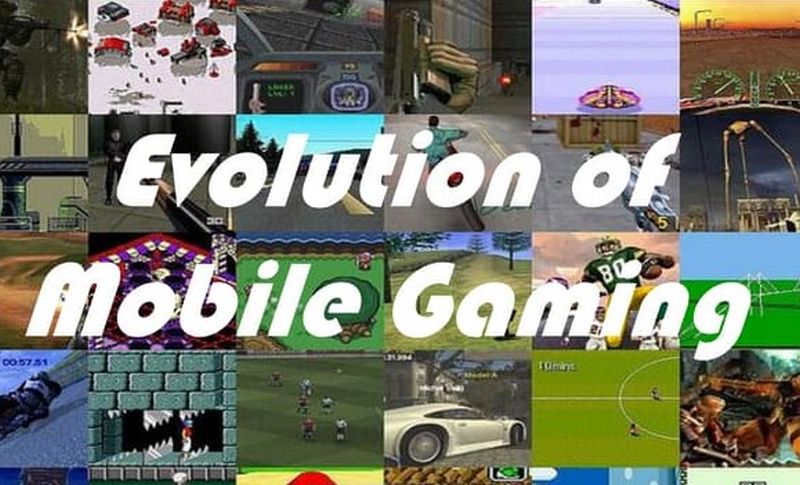Mobile gaming has undergone a remarkable evolution, transitioning from simple, classic titles to sophisticated experiences integrating cutting-edge technologies like augmented reality (AR). Initially, mobile games consisted of basic arcade-style games and puzzles, limited by the capabilities of early mobile devices. However, advancements in hardware and software have propelled mobile gaming into a multibillion-dollar industry.
One significant development has been the introduction of smartphones with powerful processors and high-resolution displays, enabling more complex and visually stunning games. As mobile devices became more capable, developers began to explore new genres and gameplay mechanics, leading to the rise of popular titles like Angry Birds, Candy Crush Saga, and Clash of Clans.

In recent years, the integration of AR technology has pushed the boundaries of mobile gaming even further. Games like Pokémon GO and Harry Potter: Wizards Unite have revolutionized the gaming experience by blending virtual elements with the real world, allowing players to interact with their surroundings in novel ways.
Looking ahead, the evolution of mobile gaming is expected to continue, with advancements in technologies like virtual reality (VR), artificial intelligence (AI), and 5G connectivity opening up even more possibilities for immersive and engaging experiences on the go. As mobile devices become more powerful and ubiquitous, the future of gaming is undoubtedly mobile.
Table Of Contents.
The Evolution of Mobile Gaming
From Snake to Complex Mobile Games
The Evolution of Immersive Mobile Games.
Mobile gaming.
Mobile gaming has become a ubiquitous and rapidly growing segment of the gaming industry, thanks to the widespread availability of smartphones and tablets. With millions of games available for download on app stores, mobile gaming offers a diverse range of experiences catering to various interests and demographics.
One of the key advantages of mobile gaming is its accessibility. Players can enjoy games anytime, anywhere, whether they’re waiting for a bus or relaxing at home. This accessibility has led to the democratization of gaming, with people of all ages and backgrounds participating.
Furthermore, the evolution of mobile hardware and software has allowed for increasingly immersive and high-quality gaming experiences. From casual puzzle games to graphically stunning action titles, mobile games offer something for everyone.
Another significant aspect of mobile gaming is its social element. Many mobile games incorporate multiplayer features, allowing players to connect and compete with friends or strangers from around the world. This social aspect enhances the overall gaming experience and fosters communities around popular games.
Additionally, the mobile gaming industry continues to innovate with emerging technologies such as augmented reality (AR) and virtual reality (VR), promising even more immersive and interactive experiences in the future. Overall, mobile gaming has become a vibrant and integral part of the gaming landscape, with its popularity showing no signs of slowing down.

The Evolution of Mobile Gaming.
The evolution of mobile gaming has been a remarkable journey, transforming from simple pixelated games to sophisticated experiences that rival traditional console gaming. Initially, mobile games were rudimentary, often limited to basic puzzles or arcade-style titles due to the constraints of early mobile devices.
However, with the advent of smartphones and tablets equipped with powerful processors and high-resolution displays, mobile gaming underwent a dramatic shift. Developers began creating more complex and visually stunning games, expanding into various genres like action, adventure, strategy, and role-playing.
The rise of app stores provided a platform for developers to distribute their games to a global audience easily. This accessibility fueled the growth of the mobile gaming industry, attracting both casual and hardcore gamers alike.
Furthermore, the integration of social features, such as multiplayer modes and online leaderboards, added a new dimension to mobile gaming by allowing players to connect and compete with friends and strangers worldwide.
In recent years, advancements in technology like augmented reality (AR) and virtual reality (VR) have pushed the boundaries of mobile gaming even further, offering immersive and interactive experiences that blur the line between the virtual and real worlds.
As smartphones continue to evolve, with improvements in graphics, processing power, and connectivity, the future of mobile gaming looks incredibly promising, with endless possibilities for innovation and creativity.
Advancements in Graphics and Gameplay:
Advancements in graphics and gameplay have propelled mobile gaming to new heights. With the introduction of powerful processors and high-resolution displays in smartphones, developers can create visually stunning games with intricate details and lifelike animations. This has led to more immersive gaming experiences, drawing

players into vibrant virtual worlds. Furthermore, innovations in gameplay mechanics, such as intuitive touch controls and augmented reality features, have enhanced the overall gaming experience on mobile devices. These advancements continue to push the boundaries of what is possible in mobile gaming, providing players with engaging and captivating experiences on the go.
Early Mobile Games:
Early mobile games were characterized by simplicity and limited capabilities due to the constraints of early mobile devices. These games typically featured basic graphics and straightforward gameplay mechanics, often centered around classic arcade-style games like Tetris, Snake, and Pac-Man. Due to the small screens and limited processing power of early mobile phones, the scope and complexity of these games were relatively modest. Despite their simplicity, early mobile games laid the foundation for the thriving mobile gaming industry we see today, paving the way for advancements in technology and the development of more sophisticated and immersive gaming experiences.
Console-Quality Experiences.
Modern mobile games now offer console-quality experiences with stunning graphics, immersive gameplay, and rich storytelling. Thanks to advancements in hardware and software, smartphones can rival the capabilities of traditional gaming consoles, providing players with high-fidelity experiences on the go.
Impact on Gaming Devices.

The evolution of mobile gaming has had a significant impact on gaming devices, with smartphones and tablets increasingly becoming the platform of choice for gamers. This shift has spurred innovation in hardware and software, driving improvements in graphics, performance, and gameplay across all gaming devices.
Technological Innovations.
enabling immersive experiences with features like augmented reality (AR), virtual reality (VR), and advanced graphics. Additionally, advancements in hardware, such as powerful processors and high-resolution displays, have elevated the quality of mobile games, providing players with unparalleled gaming experiences on their smartphones and tablets From
Snake to Complex Mobile Games.

The journey from the iconic “Snake” game to the complex mobile games of today represents a remarkable evolution in the world of mobile gaming. “Snake” was a simple yet addictive game that came pre-installed on early Nokia mobile phones, featuring a basic concept of controlling a snake to eat pellets and grow longer without colliding with itself.
As mobile technology advanced, so did the capabilities of mobile games. Developers began to explore more sophisticated gameplay mechanics, graphics, and storytelling, leading to the creation of a wide range of complex mobile games across various genres. From immersive role-playing adventures to fast-paced action games and intricate puzzle challenges, the diversity of mobile gaming experiences expanded exponentially.
The introduction of smartphones with powerful processors, high-resolution displays, and advanced sensors paved the way for even more immersive and visually stunning games. Additionally, the rise of app stores provided developers with a platform to distribute their games to a global audience, further fueling innovation and creativity in the mobile gaming industry.
Today, mobile games offer intricate storylines, stunning graphics, multiplayer modes, and social features, providing players with engaging and immersive experiences on their smartphones and tablets. The journey from “Snake” to complex mobile games highlights the incredible advancements in technology and creativity that have transformed the mobile gaming landscape into a thriving and diverse industry.
The Evolution of Immersive Mobile Games.
The evolution of immersive mobile games has been a fascinating journey marked by significant technological advancements and creative innovation. Initially, mobile games were limited in scope and immersion due to the constraints of early mobile devices, featuring simple graphics and gameplay mechanics.
However, with the advent of smartphones equipped with powerful processors, high-resolution displays, and advanced sensors, the potential for immersive gaming experiences on mobile devices expanded exponentially. Developers began to leverage these capabilities to create games with stunning graphics, lifelike animations, and responsive touch controls, drawing players into rich and engaging virtual worlds.
The introduction of augmented reality (AR) and virtual reality (VR) further revolutionized immersive mobile gaming. AR games overlay virtual elements onto the real-world environment, allowing players to interact with digital objects and characters in their surroundings. Meanwhile, VR games transport players to entirely virtual environments, providing an unparalleled sense of presence and immersion.

Furthermore, advancements in network technology, such as 5G connectivity, have enabled seamless multiplayer experiences in immersive mobile games, allowing players to connect and compete with friends and strangers in real-time. As technology continues to evolve, the future of immersive mobile games holds even greater potential, with innovations such as haptic feedback, spatial audio, and AI-driven experiences promising to push the boundaries of immersion further. The evolution of immersive mobile games reflects the ongoing pursuit of creating captivating and immersive experiences that blur the lines between the virtual and real worlds.
FAQs:
What is the top 10 mobile game?
The top 10 mobile games often vary based on popularity, downloads, and revenue. As of my last update, popular titles included “PUBG Mobile,” “Garena Free Fire,” “Candy Crush Saga,” “Among Us,” “Clash of Clans,” “Roblox,” “Subway Surfers,” “Gardenscapes,” “Coin Master,” and “Fortnite.” However, rankings may change over time.
Which is the first mobile gaming?
The first mobile game is widely considered to be “Tetris,” developed by Alexey Pajitnov in 1984. It was initially released for the Electronika 60 computer in the Soviet Union. However, it gained widespread popularity when it was ported to various platforms, including mobile devices, in the late 1980s and early 1990s.
How is augmented reality used in gaming?
Augmented reality (AR) is used in gaming to overlay digital elements onto the real-world environment seen through a device’s camera. This allows players to interact with virtual objects and characters in their surroundings, creating immersive gaming experiences. Games like Pokémon GO and Harry Potter: Wizards Unite utilize AR to bring virtual worlds to life.
What is the growth of mobile gaming industry?
The mobile gaming industry has experienced exponential growth, driven by the widespread adoption of smartphones and tablets. With advancements in technology, accessibility, and monetization strategies, the industry’s revenue has surged, reaching billions of dollars annually. Mobile gaming continues to dominate the gaming market, showing no signs of slowing down.
